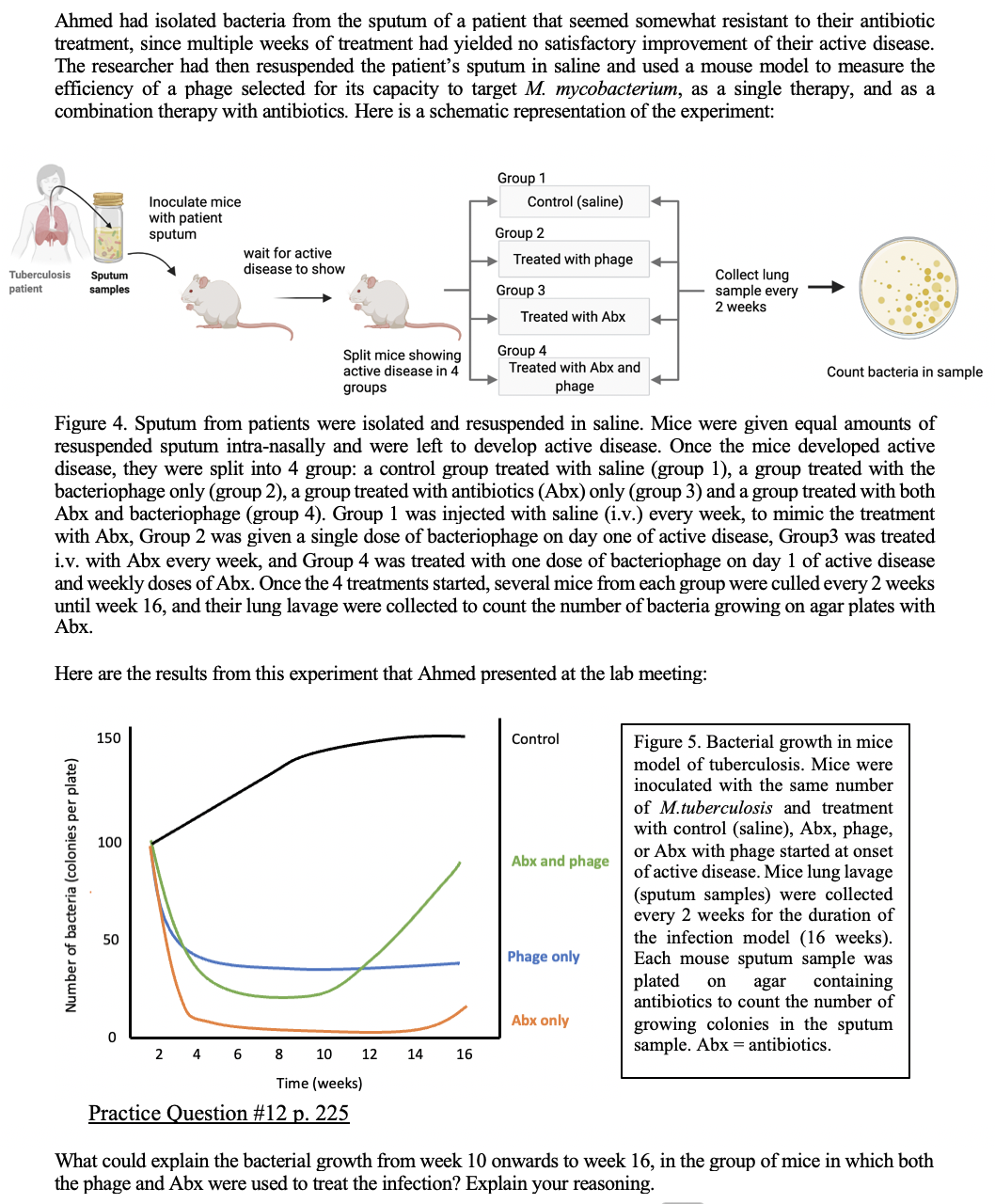Ahmed had isolated bacteria from the sputum of a patient that seemed somewhat resistant to their antibiotic treatment, since multiple weeks of treatment had yielded no satisfactory improvement of their active disease. The researcher had then resuspended the patient's sputum in saline and used a mouse model to measure the efficiency of a phage selected for its capacity to target M. mycobacterium, as a single therapy, and as a combination therapy with antibiotics. Here is a schematic representation of the experiment: Group 1 Control (saline) Inoculate mice with patient sputum Group 2 wait for active disease to show Treated with phage Collect lung sample every 2 weeks Tuberculosis Sputum patient samples Group 3 Treated with Abx Split mice showing active disease in 4 Group 4 Treated with Abx and Count bacteria in sample groups phage Figure 4. Sputum from patients were isolated and resuspended in saline. Mice were given equal amounts of resuspended sputum intra-nasally and were left to develop active disease. Once the mice developed active disease, they were split into 4 group: a control group treated with saline (group 1), a group treated with the bacteriophage only (group 2), a group treated with antibiotics (Abx) only (group 3) and a group treated with both Abx and bacteriophage (group 4). Group 1 was injected with saline (i.v.) every week, to mimic the treatment with Abx, Group 2 was given a single dose of bacteriophage on day one of active disease, Group3 was treated i.v. with Abx every week, and Group 4 was treated with one dose of bacteriophage on day 1 of active disease and weekly doses of Abx. Once the 4 treatments started, several mice from each group were culled every 2 weeks until week 16, and their lung lavage were collected to count the number of bacteria growing on agar plates with Abx. Here are the results from this experiment that Ahmed presented at the lab meeting: 150 Control Figure 5. Bacterial growth in mice model of tuberculosis. Mice were inoculated with the same number of M.tuberculosis and treatment with control (saline), Abx, phage, or Abx with phage started at onset of active disease. Mice lung lavage (sputum samples) were collected every 2 weeks for the duration of the infection model (16 weeks). Each mouse sputum sample was plated antibiotics to count the number of 100 Abx and phage 50 Phage only on agar containing Abx only growing colonies in the sputum sample. Abx = antibiotics. 2 4 6 8 10 12 14 16 Time (weeks) Practice Question #12 p. 225 What could explain the bacterial growth from week 10 onwards to week 16, in the group of mice in which both the phage and Abx were used to treat the infection? Explain your reasoning. Number of bacteria (colonies per plate)
Genetic Recombination
Recombination is crucial to this process because it allows genes to be reassorted into diverse combinations. Genetic recombination is the process of combining genetic components from two different origins into a single unit. In prokaryotes, genetic recombination takes place by the unilateral transfer of deoxyribonucleic acid. It includes transduction, transformation, and conjugation. The genetic exchange occurring between homologous deoxyribonucleic acid sequences (DNA) from two different sources is termed general recombination. For this to happen, an identical sequence of the two recombining molecules is required. The process of genetic exchange which occurs in eukaryotes during sexual reproduction such as meiosis is an example of this type of genetic recombination.
Microbial Genetics
Genes are the functional units of heredity. They transfer characteristic information from parents to the offspring.

Step by step
Solved in 2 steps with 2 images


